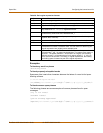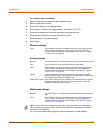
Spam filter Configuring the banned word list
FortiGate-100A Administration Guide 01-28007-0068-20041203 337
Examples
To block any word in a phrase
/block|any|word/
To block purposely misspelled words
Spammers often insert other characters between the letters of a word to fool spam
blocking software.
/^.*v.*i.*a.*g.*r.*a.*$/i
/cr[eéèêë][\+\-\*=<>\.\,;!\?%&§@\^°\$£€\{\}()\[\]\|\\_01]dit/i
To block common spam phrases
The following phrases are some examples of common phrases found in spam
messages.
/try it for free/i
/student loans/i
/you’re already approved/i
/special[\+\-\*=<>\.\,;!\?%&~#§@\^°\$£€\{\}()\[\]\|\\_1]offer/i
[Aa]bc either of Abc and abc
[abc]+ any (nonempty) string of a's, b's and c's (such as a, abba, acbabcacaa)
[^abc]+ any (nonempty) string which does not contain any of a, b and c (such as defg)
\d\d any two decimal digits, such as 42; same as \d{2}
/i makes the pattern case insensitive. For example, /bad language/i blocks
any instance of bad language regardless of case.
\w+ a “word”: a nonempty sequence of alphanumeric characters and low lines
(underscores), such as foo and 12bar8 and foo_1
100\s*mk the strings 100 and mk optionally separated by any amount of white space
(spaces, tabs, newlines)
abc\b abc when followed by a word boundary (e.g. in abc! but not in abcd)
perl\B perl when not followed by a word boundary (e.g. in perlert but not in perl stuff)
\x tells the regular expression parser to ignore white space that is neither
backslashed nor within a character class. You can use this to break up your
regular expression into (slightly) more readable parts.
/x used to add regexps within other text. If the first character in a pattern is
forward slash '/', the '/' is treated as the delimiter. The pattern must contain a
second '/'. The pattern between ‘/’ will be taken as a regexp, and anything
after the second ‘/’ will be parsed as a list of regexp options ('i', 'x', etc). An
error occurs If the second '/' is missing. In regular expressions, the leading
and trailing space is treated as part of the regular expression.
Table 30: Perl regular expression formats


















